| National Museum of Erotica
Victorian Politician Auctions Erotic Art Collection Items from Australia’s first National Museum of Erotica have been listed for sale through Lawson’s auction house. The online auction, entitled ‘Body Politics’, is owned by Victorian MLC Fiona Patten and her partner Robbie Swan. The two have been collecting erotic art and ephemera since the early 1990s. The items can be viewed on Lawson’ site at: . Click here Body Politics opened Australia’s first National Museum of Erotica on 1st March 2001 in Canberra. The ribbon was cut and the plaque unveiled by the ACT’s Chief Minister, Kate Carnell who called it ‘inspired’ and ‘timely’. After publicly displaying the initial collection for a year, the Museum was dismantled and put into mothballs while it was catalogued and expanded. By the end of 2005 it comprised over 400 individual pieces with an Australian erotic art section that included original works by Brett Whitely, Charles Blackman, Salvatore Zoffrea, Lesbia Thorpe, Richard Larter, and Marie Azzopardi. The collection and archiving of erotic, pornographic and sexual art (and artefacts) is fundamentally different from the collection of non sexual material because the former is a rapidly diminishing resource in the world. Every day, erotic art and artefact is destroyed in a way that mainstream art is not subjected to. These are:
|
   |
| The development of erotic and pornographic film culture in Australia is well represented in the Museum. Old movie posters that trace the development of sexuality from the 1940s to the 1990s form a solid part of the collection as do earlier technologies like a collection of black and white stereo cards of ‘Life Drawing’ models, viewed through a specialist set of viewing frames. A collection of 70, ‘Super 8’ colour and black and white films that were shown to patrons of Melbourne's Shaft and Crazy Horse Cinemas from the early 1970s to the 1990s, shows how this medium influenced sexual ideas of the time. Films like ‘Bisexuality’ and ‘Black Fucker’ had a major influence on the acceptance of gay culture and also multiculturalism – although mainstream research institutions would rarely attribute this. A feature of this collection is a super 8 film in a can simply labelled ‘Linda’ which is a rare print of what is believed to be the first sexual film that Linda Lovelace made – possibly a couple of years before she made Deep Throat and involving equally controversial themes. |
   |
| Erotic themes in literature are represented in a variety of ways. A collection of a dozen small illustrated booklets from the 1920s shows bestiality, oral and anal sex, interracial sex and the sexual lampooning of celebrities in the most explicit ways. Comic strip characters like Dagwood and Blondie as well as screen idols like Wheeler and Woolsley were popular with the mainstream artists who frequently drew these anonymous tomes. More recently the Museum boasts the only erotic cover ever to grace The Phantom comic and an example of modern pornographic street comic art in Australia by Mark Morte. |
    |
| The Museum houses an interesting vibrator collection which includes an early 1890 mechanical device and one of the first battery-operated vibrators which was left in a brothel during the second world war by a visiting American sailor. The Museum holds the prototype of what is believed to be the first commercial vibrator made in Australia. Constructed in Sydney in the early 1960s it is made using an old Embassy-brand plastic torch, a Scalelectrix slot car motor and a cast of the owner’s penis made from a rubber prosthetic compound. The owner sold nearly a thousand pieces, mainly on Army bases, until he was threatened by corrupt police officers in the Askin administration for encroaching on their turf! |
 |
| One of the greatest series of etchings from the Victorian period is represented through the Hungarian master, Michaely Von Zichy. This court painter to the Russian Tzars sketched his sexual autobiography in the mid to late 1800s and after he died, a collection of over 40 of the copperplate etchings was published in Liepzig (in a bound edition of 330) entitled Liebe (Love). Through two world wars and the fall of communism in Eastern Europe, no one is sure how many of these original volumes still exist. Some experts say less than 100. The Museum sensitively framed one of these volumes in 2002 and invited the Hungarian Embassy in Canberra to open the exhibition to the public. In doing so, First Secretary told the media that it was the first time that he knew this had happened. |
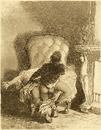 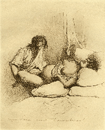 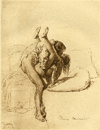 |
| The Museum houses a small but interesting collection of Japanese erotica. The feature item is a four metre scroll from the middle Edo period entitled, Miso No De Banasi or Flowers Into Water. Other Shunga in this collection includes a series of four woodblock prints said to be from Utamaro’s school and a ‘pillow’ book from the same period. Rare as this material is already, the Museum also has a small selection of very rare Japanese photos showing couples making love from the war years. |
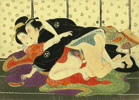 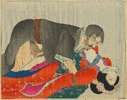 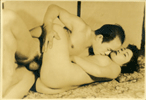 |
| The ‘French Postcard’ is represented through a set of 12 portraits from Paris in the 1920s, the British bawdy ‘seaside’ postcards of the 1940s are there and some surprising Australian cards of the 1930s that shamelessly promoted cigarettes with cleavage and a sexy smile. |
  |
| The British fixation with spanking is documented in a series of three original wartime watercolours that were clearly painted for a serviceman’s calendar or similar. With hand printed names like ‘Cleared for Action’ and ‘Yell for Leather’, (the latter showing a schoolboy’s bare bottom being spanked by an attractive young Ms) these images show us how one decade’s popular fantasy can very quickly become another’s politically incorrect ‘depravity’. |
  |
| Through the 1960s the ‘pin-up’ calendar became the art form of the office kitchen and the mechanic’s workshop. But due to their lack of robustness and the fact that they were only meant to last a year at most, there are very few remaining from this era. The Museum has a few of these in its archivcs with the most notable being one from the Albury Star Service Station in the 1950s. |
  |
| Paraphenalia from old Australian brothels is hard to find and authenticate. This is not helped by the fact that prostitution has been illegal in most states since the early 1800s. However some does remain and the Museum has amongst this material a pair of spelter statuettes that graced the reception area of a Fitzroy brothel in the early 1900s. Inscribed on a small copper plaque at the base are ‘Confidence’ and ‘Discretion’. They were probably made at the Geelong spelterworks. |
 |
| Enquiries about leasing, buying, selling or further investigating any of the items in the collection should be emailed to: robbie@bodypolitics.com.au |
| | links | contact us | home | |
















